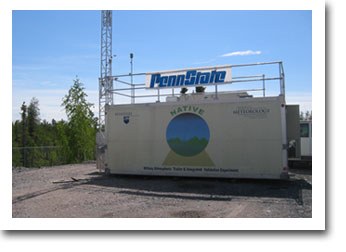NASA's new 'Earth Venture' projects to include Penn State air quality component
In a 27 May 2010 news release, NASA announced that it will fund five new proposals aimed at studying hurricanes, air quality, and Arctic ecosystems over the next five years. The proposals, which were competitively-selected, are part of a new Venture-class series of low-to-moderate cost projects. The Earth Venture missions, as they are called, are small, targeted science investigations that complement NASA's larger research missions and satellites.
 What does this mean for Penn State? One of these proposals, led by Principal Investigator James Crawford at NASA Langley, will include a Penn State subcontract with faculty member Anne Thompson as PI, to operate the Nittany Atmospheric Trailer and Integrated Validation Experiment (NATIVE) facility, along with NASA aircraft, to study air quality in four U.S. urban regions over the next five years. The project, led by James Crawford, is titled "Deriving Information on Surface Conditions from Column and Vertically Resolved Observations Relevant to Air Quality" (DISCOVER-AQ)" will look at complex interactions of natural and human sources of ozone, carbon monoxide and atmospheric particles inWashington, DC; Houston, central California, and Atlanta. "Each of these areas is different in pollution types--industry, petrochemicals, traffic--as well as in ecosystems that can contribute naturally to the mix of chemicals that make particles." Thompson says. "We are also studying how weather systems and different cloud conditions affect the sampling ability of NATIVE and aircraft. This is because NASA's ultimate goal is to launch a geostationary satellite to track air pollution that circles the globe, from Asia to the US, from the US to Europe, the Middle East and back to rapidly changing parts of eastern Asia." The funding to Penn State will support graduate students studying air quality. NATIVE, equipped with a suite of standard sensors for air pollution, also operates radiometers and sends up ozone-weather balloons to ground -truth today's NASA satellites. Assembled at Penn State in 2006, NATIVE has previously supported NASA aircraft experiments in Houston, central Washington State, northern Canada and Panama. Later this month, Thompson, Post-doctoral Associate Doug Martins, and two Penn State students will operate NATIVE at NASA Langley in Hampton, Virginia, to test new instruments in preparation for a 2011 DISCOVER-AQ deployment with NASA's P-3B aircraft.
What does this mean for Penn State? One of these proposals, led by Principal Investigator James Crawford at NASA Langley, will include a Penn State subcontract with faculty member Anne Thompson as PI, to operate the Nittany Atmospheric Trailer and Integrated Validation Experiment (NATIVE) facility, along with NASA aircraft, to study air quality in four U.S. urban regions over the next five years. The project, led by James Crawford, is titled "Deriving Information on Surface Conditions from Column and Vertically Resolved Observations Relevant to Air Quality" (DISCOVER-AQ)" will look at complex interactions of natural and human sources of ozone, carbon monoxide and atmospheric particles inWashington, DC; Houston, central California, and Atlanta. "Each of these areas is different in pollution types--industry, petrochemicals, traffic--as well as in ecosystems that can contribute naturally to the mix of chemicals that make particles." Thompson says. "We are also studying how weather systems and different cloud conditions affect the sampling ability of NATIVE and aircraft. This is because NASA's ultimate goal is to launch a geostationary satellite to track air pollution that circles the globe, from Asia to the US, from the US to Europe, the Middle East and back to rapidly changing parts of eastern Asia." The funding to Penn State will support graduate students studying air quality. NATIVE, equipped with a suite of standard sensors for air pollution, also operates radiometers and sends up ozone-weather balloons to ground -truth today's NASA satellites. Assembled at Penn State in 2006, NATIVE has previously supported NASA aircraft experiments in Houston, central Washington State, northern Canada and Panama. Later this month, Thompson, Post-doctoral Associate Doug Martins, and two Penn State students will operate NATIVE at NASA Langley in Hampton, Virginia, to test new instruments in preparation for a 2011 DISCOVER-AQ deployment with NASA's P-3B aircraft.
